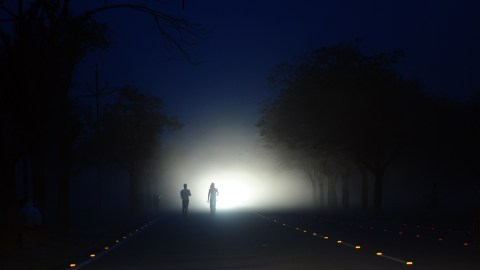This mysterious sound drives some to insanity, suicide

The New Mexico town of Taos is artsy and picturesque, bringing in tons of tourists each year for its pueblo, arts festival, and other trappings. The town has had several celebrity residents including Aldous Huxley, D.H. Lawrence, Julia Roberts, and Dennis Hopper. But there is a dark phenomenon underlying this eclectic desert oasis, a mysterious sound that only a handful can hear, and a small few are tormented by. It’s called the Taos Hum.
Though perhaps the most famous case, it isn’t only in Taos. Other mysterious droning sounds have cropped up in Windsor, Ontario, Bristol, England, and Largs, Scotland, to name a few. Dozens of cities and small towns around the world have logged reports. Because of this, sometimes it’s called the “Worldwide Hum” or merely “The Hum.” To see if there’s one near you, check out the World Hum Map and Database Project.
Only 2% of the Taos population can hear the incessant vibration which usually grows louder at night. “Hearers” explain it as a hum, a throbbing sound, or a low rumbling which can only be heard indoors. Those who live in rural areas or the suburbs are more likely to hear it over city dwellers. A city usually offers enough background noise to drown it out.
69 year-old Katie Jacques told the BBC that she considered the Bristol Hum “a kind of torture.” She said, “Sometimes you just want to scream.” Jacques went on, “It has a rhythm to it – it goes up and down. It sounds almost like a diesel car idling in the distance and you want to go and ask somebody to switch the engine off – and you can’t.” This makes sleep for her “impossible.”
Besides sleep disturbances, some hearers complain of headaches, dizziness, nausea, and even nosebleeds, as a result of constant exposure. Most tear their houses apart only to give up in vain, unable to locate the sound’s origin. And what hurts the most is sometimes those around them disbelieve, because they can’t hear it themselves.

Some hearers are prone to insomnia, among a variety of other disorders. Credit: Getty Images.
In addition to physical symptoms, constant exposure can cause anxiety, depression, and even paranoia. In the UK according to the BBC, such a hum has led to at least one suicide. Experts say cognitive behavioral therapy can help relieve symptoms.
A number of explanations for the hum have been offered ranging from the plausible to the sensational. Some conspiracy theorists say it’s a series of underground engines or emanations from a UFO crash site. In England, some surmise that the sound comes from vibrations that are part of the Midshipman fish’s mating ritual.
Others still say it’s coming out of a secret government project, originating from the High Frequency Active Auroral Research Program (HAARP). This is operated out of an isolated military installation in Alaska that uses radio waves to scan outer space and test new modes of communication. More logical possibilities include unusual seismic activity, high power lines, high-pressure gas lines, and otoacoustic emissions, or vibrations of tiny hair cells from within the ear. It could also just be a case of mass hysteria, but most experts don’t think so.

Could the hum be caused by the same kind of technology used to communicate with submerged submarines? Credit: Getty Images.
UK newspapers first remarked on the “Bristol hum” back in the late ’70s. Some 800 people claimed to have heard it. But it wasn’t until the spring of 1991, when a number of Taos residents complained of a constant hum, that widespread media attention was given.
This in turn sparked an investigation by scientists from Los Alamos and Sandia National Laboratories, among other institutions. Yet, they were unable to locate the hum’s origin. In the ’90s, engineering professor Joe Mullions of the University of New Mexico, placed sensitive instruments in the homes of a number of different hearers, but didn’t detect anything unusual.
Kokomo, Indiana has its own hum. Back in 2003, the municipal government ponied up the funds to have theirs looked into. Turns out, two factories near the area were producing noises at certain frequencies which residents were hearing. Borneo residents in 2012 complained of a low rumbling early in the morning, only to discover it to be boiler testing at a local factory.
Yet, so far no line of inquiry has been able to grab any clues on the Taos Hum. Geoscientist David Deming, himself a hearer, began researching this particular anomaly in 2004. He now believes the sound is due to Very Low Frequency (VLF) radio waves (between 3 kHz and 30 kHz). The US military uses them to communicate with submerged submarines. If it is indeed them, the next question might be: Why would these be bouncing around the desert?
To learn more about the Taos Hum, click here:





